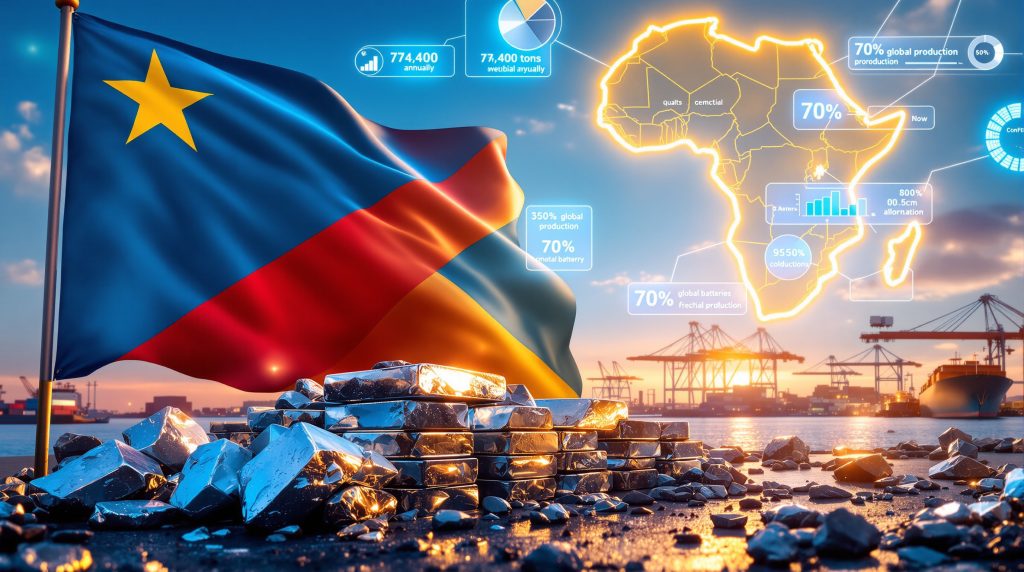Congo cobalt export approvals represent a critical regulatory mechanism controlling the global flow of cobalt from the Democratic Republic of Congo (DRC), which supplies over 70% of the world's cobalt production. These approvals determine when, how much, and under what conditions cobalt can leave the country, directly impacting electric vehicle battery supply chains, technology manufacturing, and global cobalt pricing.
The Democratic Republic of Congo has fundamentally transformed its approach to cobalt exports through a sophisticated quota system that replaced months of complete export suspension. This regulatory shift affects every participant in the global cobalt supply chain, from mining companies operating in the DRC to electric vehicle manufacturers in China, Europe, and North America.
Understanding the Current Export Framework
The DRC's cobalt export system operates through the Strategic Mineral Substances Market Regulation and Control Authority (ARECOMS), which replaced the previous export suspension with a structured quota mechanism on October 16, 2025. This regulatory shift fundamentally changed how international buyers access Congolese cobalt, moving from market-driven supply to state-controlled allocation.
Under this framework, companies must navigate complex approval processes that combine traditional mining regulations with sophisticated supply chain tracking requirements. The system requires pre-payment of royalties, quality validation certificates, and comprehensive traceability documentation before any cobalt can leave Congolese territory.
Furthermore, the implementation of Congo cobalt export approvals has created ripple effects across global supply chains. Mining companies now face unprecedented regulatory oversight that extends beyond traditional compliance requirements.
How Does the Congo Cobalt Quota System Actually Work?
Monthly Application and Approval Process
Companies seeking to export cobalt must navigate a multi-step approval process that begins with monthly quota applications submitted to ARECOMS. The regulatory body evaluates these requests against allocated quotas, which are distributed based on historical export performance from 2022-2024.
Key Requirements for Export Approval:
• Pre-payment of royalties calculated on assigned volumes
• Quality validation certificates from approved laboratories
• Comprehensive traceability documentation
• ARECOMS oversight during product sampling
• Compliance with monthly volume limits
• Digital tracking certificates for all exported material
The application process typically requires 5-10 business days for quota confirmation, followed by 7-14 business days for compliance verification. However, industry sources report that final approvals are currently experiencing delays beyond these standard timeframes, with companies waiting weeks for operational clearances despite having submitted complete applications.
The "Use-It-Or-Lose-It" Policy Structure
The quota system operates on strict monthly resets, meaning unused allocations cannot be carried forward beyond specific timeframes. For 2025, companies could roll over unused volumes within the calendar year, but starting in 2026, monthly quotas reset without carryover provisions.
Current Quota Allocations:
| Period | Total Volume | Monthly Average | Strategic Reserve |
|---|---|---|---|
| Q4 2025 | 18,125 metric tons | 6,042 tons | 10% held by ARECOMS |
| 2026 | 77,400 tons annually | 6,450 tons | 7,740 tons government allocation |
| 2027 | 77,400 tons annually | 6,450 tons | Maintained reserve structure |
This structure creates significant pressure on mining companies to maintain consistent production schedules and logistics capabilities, as any unused monthly allocation represents lost revenue opportunity that cannot be recovered in subsequent periods.
What Caused the Shift to Export Approvals in 2025?
From Export Ban to Controlled Quotas
The current approval system emerged following a months-long export suspension that began in February 2025 when cobalt prices hit nine-year lows of $10 per pound. President Félix Tshisekedi's administration implemented the ban to address what government officials termed market manipulation that kept cobalt prices artificially depressed despite strong global demand from electric vehicle manufacturers.
The export restrictions were designed as a direct response to what Congolese officials viewed as "predatory market strategies" that prevented fair value realisation for the country's most strategic mineral resource. This represented a significant shift from previous policies that prioritised production volume over price optimisation.
In addition, this transformation aligns with broader global trends in critical minerals energy security as nations seek to maintain control over strategic resources. Similarly, international responses have included initiatives such as the critical minerals executive order in the United States.
Market Intervention Success Metrics
The export restrictions achieved their intended price recovery objectives, with cobalt prices surging 92% from March to October 2025. This dramatic price rebound validated the government's strategy of using supply control as a market intervention tool, demonstrating the significant influence that Congolese production decisions wield over global cobalt markets.
Price Recovery Timeline:
• February 2025: $10/lb (nine-year low point)
• March 2025: Export ban implementation begins
• June 2025: Prices reach $14/lb (40% recovery)
• October 2025: $19/lb (92% total increase)
• Current trajectory: Sustained pricing above $18/lb
The success of this price intervention strategy has encouraged other mineral-producing nations to consider similar supply control mechanisms for their strategic resources, potentially reshaping global commodity market dynamics.
Which Companies Receive the Largest Export Allocations?
Major Producer Quota Distribution
The quota allocation system heavily favours established mining operations with proven export histories, creating a tiered structure that reflects historical market participation and production capacity. This approach prioritises operational continuity while limiting opportunities for new market entrants.
| Company | Q4 2025 Allocation | 2026 Annual Allocation | Primary Mine Operations |
|---|---|---|---|
| CMOC | 6,650 tons | 31,920 tons | Tenke Fungurume, Kisanfu |
| Glencore | 3,925 tons | 18,840 tons | Kamoto Copper Company, Mutanda Mining |
| Other Producers | 5,737 tons | 26,640 tons | Various smaller operations |
| ARECOMS Strategic | 1,813 tons | 7,740 tons | Government discretionary reserve |
CMOC's dominant position in the allocation structure reflects their significant investments in Congolese mining infrastructure, including the Tenke Fungurume mine and the recently expanded Kisanfu operation. Their combined allocation represents approximately 37% of total quota volumes, establishing them as the primary beneficiary of the new system.
Glencore's allocation, while smaller than CMOC's, still represents substantial volumes given their integrated global trading operations. Their Kamoto Copper Company and Mutanda Mining operations have historically been major contributors to global cobalt supply, making their continued access critical for international market stability.
Industry Response to Allocation Methods
The quota distribution has generated mixed reactions across the mining sector, reflecting different strategic priorities and investment positions. Glencore has publicly supported the new regulatory framework, viewing it as a mechanism for market stabilisation that benefits all participants through higher prices and reduced volatility.
Conversely, CMOC has opposed the quota system, particularly given their recent production expansion investments that may not fully benefit under historical allocation methods. Their opposition reflects concerns that the system may limit their ability to capitalise on increased production capacity from recent infrastructure investments.
However, other companies have found different approaches to navigate this regulatory landscape. For instance, the cobalt project expansion in Australia demonstrates how alternative supply sources are developing in response to Congo's export controls.
The quota system represents a fundamental shift toward resource nationalism, where mineral-rich countries prioritise strategic control over market-driven allocation mechanisms.
What Are the Compliance Requirements for Export Approvals?
Traceability and Quality Standards
ARECOMS has implemented comprehensive oversight mechanisms designed to enhance supply chain transparency and combat illicit mining activities. These requirements represent a significant upgrade in regulatory sophistication compared to previous export systems, incorporating digital tracking technologies and real-time monitoring capabilities.
Mandatory Compliance Elements:
• Digital traceability certificates for all exported cobalt with blockchain verification
• Third-party quality verification from ARECOMS-approved laboratories
• Real-time sampling oversight by ARECOMS officials during loading operations
• Pre-shipment royalty payments calculated on current market prices rather than historical averages
• Monthly production reporting including inventory levels and processing capacity utilisation
• Environmental compliance documentation covering mining and processing operations
• Social responsibility verification including community impact assessments
Enforcement and Penalty Structure
Companies that violate quota allocations or compliance requirements face severe consequences, including permanent export ban possibilities and asset forfeiture provisions. ARECOMS retains authority to purchase cobalt stocks that exceed quarterly quotas at predetermined prices, effectively preventing unauthorised accumulation while ensuring government control over surplus production.
The penalty structure includes graduated sanctions that begin with temporary suspension for minor violations and escalate to permanent exclusion for serious compliance failures. This approach provides companies with incentives to maintain strict adherence to regulatory requirements whilst ensuring that violations carry meaningful consequences.
Furthermore, recent cases such as the cobalt compliance case involving Barrick Gold demonstrate how regulatory oversight is intensifying globally across cobalt operations.
How Do Export Delays Impact Global Supply Chains?
Current Approval Timeline Challenges
Despite the October 16, 2025 implementation date, multiple industry sources report ongoing delays in receiving final export approvals. Companies have submitted applications and received quota allocations but continue waiting for operational clearances to resume shipments, creating uncertainty throughout international supply chains.
Typical Processing Timeline:
• Application submission: Monthly deadline (typically 25th of preceding month)
• Quota confirmation: 5-10 business days (currently meeting targets)
• Compliance verification: 7-14 business days (experiencing delays)
• Final approval: Variable timeline (currently 3-4 weeks behind schedule)
• Shipping authorisation: 2-3 business days post-approval
• Port clearance: Additional 1-2 business days
Industry sources indicate that the delays primarily stem from ARECOMS capacity constraints in processing the volume of applications rather than specific compliance issues with individual companies. The regulatory body has hired additional staff to address these bottlenecks, but training requirements have slowed the acceleration of approval processes.
Global Manufacturing Impact Assessment
The approval delays create cascading effects throughout international supply chains, particularly affecting Chinese battery manufacturers who rely heavily on Congolese cobalt for lithium-ion battery production. With typical shipping times of three months from Congo to China, October shipments would arrive in January 2026, meaning current delays push deliveries into Q2 2026.
Supply Chain Ripple Effects:
• Extended lead times forcing battery manufacturers to increase inventory buffers by 30-45 days
• Increased working capital requirements as companies must finance longer inventory holding periods
• Production scheduling adjustments requiring manufacturers to source alternative materials for immediate needs
• Contract renegotiation pressures as delivery timelines no longer align with original agreements
• Premium pricing for spot market cobalt from alternative sources during shortage periods
Chinese electric vehicle manufacturers have been particularly affected, with several major producers reporting production line adjustments to accommodate reduced cobalt availability. These adjustments include accelerated development of cobalt-reduced battery chemistries and increased sourcing from Australian and Canadian suppliers.
What Does This Mean for Cobalt Prices and Market Stability?
Price Volatility and Long-term Trends
The quota system has fundamentally altered cobalt market dynamics by introducing artificial scarcity into a previously oversupplied market. This regulatory intervention creates sustained upward pressure on prices whilst introducing new volatility sources related to approval timing and quota utilisation rates.
Market Impact Indicators:
• Price floor establishment around $15-18/lb based on quota-constrained supply
• Increased price volatility during monthly approval periods (typically 15-20% swings)
• Premium pricing for immediate delivery contracts (averaging $2-3/lb above standard contracts)
• Long-term contract renegotiation pressures as buyers seek price stability mechanisms
• Alternative material research acceleration with increased R&D investment in cobalt substitutes
The COMEX cobalt futures market has experienced 90% price appreciation since the February 2025 low point, with trading volumes increasing 150% as market participants adapt to the new supply dynamics. This increased volatility has attracted speculative trading interest whilst creating hedging challenges for industrial users.
Investment and Strategic Implications
The new approval regime forces international buyers to reconsider their cobalt sourcing strategies, potentially accelerating investment in alternative suppliers or substitute materials. This shift could reshape global cobalt trade patterns over the medium term, with significant implications for mining investment flows and technology development priorities.
Strategic Response Patterns:
• Diversification investments in Australian, Canadian, and other African cobalt projects
• Vertical integration strategies as manufacturers seek direct mine ownership or long-term offtake agreements
• Technology development acceleration focusing on cobalt-reduced or cobalt-free battery chemistries
• Inventory strategy modifications requiring increased working capital allocation for strategic stockpiling
• Supply chain finance innovation developing new funding mechanisms for longer inventory cycles
For investors seeking to navigate these complex market dynamics, comprehensive investing guide 2025 strategies become essential for managing commodity exposure and regulatory risks.
How Are Other Countries Responding to Congo's Export Controls?
Alternative Supply Development
Countries and companies previously dependent on Congolese cobalt are actively developing alternative supply sources, including increased mining in Australia, Canada, and other African nations. However, these alternatives currently lack the scale to fully replace Congolese production, creating medium-term supply constraints regardless of regulatory changes.
Emerging Supply Sources:
• Australian cobalt projects (primarily nickel by-products from Western Australian operations)
• Canadian exploration initiatives in Ontario and Quebec provinces
• Moroccan production expansion targeting 5,000 tons annual capacity by 2027
• Indonesian integrated operations combining nickel and cobalt production
• Recycling capacity development with target recovery rates of 15,000 tons annually by 2028
• Zambian exploration acceleration in the Copperbelt region
Australian mining companies have reported increased investment interest from international buyers seeking supply diversification. Several projects previously considered uneconomical at lower cobalt prices are now receiving development funding based on the sustained higher price environment created by Congolese export controls.
Diplomatic and Trade Responses
International governments are engaging with the DRC through diplomatic channels to ensure stable cobalt access whilst respecting the country's sovereign resource management rights. These discussions often involve broader development cooperation agreements that link mineral access to infrastructure investment and technology transfer commitments.
Key Diplomatic Initiatives:
• European Union-DRC strategic partnership negotiations covering mining regulation and development cooperation
• Chinese Belt and Road Initiative expansions specifically targeting Congolese mineral processing infrastructure
• United States critical minerals diplomacy under the Trump administration's resource security initiatives
• International Monetary Fund technical assistance programs for mineral revenue management
The United States government, under President Trump's second term, has prioritised critical mineral security as a national security issue, leading to increased diplomatic engagement with the DRC whilst simultaneously supporting domestic mining development and alternative supply chain development.
What Changes Are Expected in 2026 and Beyond?
Quota System Evolution
The DRC government has indicated potential adjustments to the quota system based on market conditions and local processing capacity development. Companies investing in Congolese refining and processing facilities may receive preferential quota allocations as part of broader industrialisation objectives.
Anticipated System Modifications:
• Bonus quotas for companies establishing local processing facilities (up to 25% allocation increases)
• Quarterly quota adjustments based on market conditions and demand fluctuations
• Enhanced digital tracking systems incorporating satellite monitoring and blockchain verification
• Expanded compliance requirements for environmental and social responsibility standards
• Regional trade agreement integration potentially linking quota access to broader economic cooperation
• Price-responsive allocation mechanisms that adjust quotas based on sustained price levels
The government has expressed particular interest in value addition requirements that would require companies to process a minimum percentage of their production within DRC territory before receiving full quota allocations. This approach aims to capture more value from cobalt resources whilst developing local industrial capacity.
Long-term Strategic Outlook
The quota system represents part of a broader resource nationalism trend, where mineral-rich countries seek greater control over their natural resources to maximise economic benefits and geopolitical influence. This approach may inspire similar policies in other critical mineral-producing nations, particularly for materials essential to energy transition technologies.
Strategic Considerations:
• Precedent setting for lithium, rare earth, and other critical mineral export controls
• Supply chain resilience planning requiring diversified sourcing strategies across multiple jurisdictions
• International trade framework implications as resource nationalism challenges traditional free trade principles
• Foreign direct investment patterns shifting toward countries offering regulatory stability
• Technology development acceleration in material substitution and recycling technologies
Other mineral-producing countries are closely monitoring the success of Congo's cobalt quota system, with several nations reportedly considering similar approaches for their strategic mineral resources. Chile has discussed lithium export controls, whilst China has implemented rare earth export restrictions, suggesting a broader trend toward strategic resource management.
Navigating Market Psychology and Investment Strategies
Understanding Market Dynamics
The psychological impact of Congo's export controls extends beyond immediate supply constraints, creating perception-driven price premiums that may persist even if alternative supplies develop. Investors and manufacturers are adapting to a fundamentally different risk environment where regulatory decisions carry equal weight to geological and technical factors.
Investment Strategy Adaptations:
• Risk premium calculations now incorporate regulatory volatility alongside traditional mining risks
• Portfolio diversification across multiple jurisdictions and mineral types
• Long-term contract structures incorporating force majeure provisions for regulatory changes
• Technology hedging through investments in alternative battery chemistries
• Vertical integration strategies reducing dependence on spot market availability
The speculative trading component in cobalt markets has increased significantly, with financial investors representing an estimated 25-30% of futures market participation compared to 10-15% before the export controls. This financialisation adds volatility whilst providing liquidity for industrial hedging activities.
Geological and Technical Considerations
Congo's cobalt dominance stems from unique geological formations in the Katanga Copperbelt that produce high-grade cobalt ores with superior metallurgical characteristics. Alternative deposits worldwide typically yield lower-grade ores requiring more intensive processing, creating cost advantages for Congolese production that persist regardless of regulatory frameworks.
Technical Quality Factors:
• Congolese cobalt grades average 0.3-0.8% compared to 0.1-0.3% in most alternative deposits
• Processing simplicity due to favourable ore mineralogy reduces production costs by 20-30%
• By-product economics from copper mining operations provide cost advantages
• Infrastructure development over decades creates logistical efficiencies difficult to replicate
These geological advantages suggest that Congo will maintain market dominance even as alternative supplies develop, making the quota system's long-term sustainability more probable than similar interventions in commodities with more distributed global production.
Conclusion: Adapting to the New Cobalt Reality
Congo cobalt export approvals represent a paradigm shift in global critical mineral governance, moving from market-driven supply allocation to state-controlled resource management. The system has successfully achieved its primary objectives of price recovery and increased government revenues, whilst creating new complexities for international supply chains that require fundamental strategic adaptations.
The 92% price recovery since implementation demonstrates the effectiveness of supply-side interventions in commodity markets, particularly for materials with concentrated geographic production. However, this success comes with increased market volatility and supply chain uncertainty that forces all participants to develop more sophisticated risk management capabilities.
Key Success Factors for Market Participants:
• Regulatory relationship management requiring dedicated resources for government engagement
• Supply chain flexibility enabling rapid adaptation to approval delays and quota changes
• Alternative sourcing development reducing dependence on any single supply source
• Technology diversification through investments in cobalt-reduced alternatives
• Financial risk management incorporating regulatory scenarios into planning processes
The system's long-term sustainability will depend on Congo's ability to balance market control with maintaining international demand and attracting continued investment in local value addition. For global stakeholders, success requires accepting higher costs and complexity whilst developing more resilient supply chain strategies.
As the global energy transition accelerates, Congo cobalt export approvals will remain a critical factor shaping battery supply chains, electric vehicle manufacturing costs, and strategic resource security planning for nations worldwide. The precedent established by this regulatory approach may influence similar policy development across other critical mineral-producing nations, making adaptability an essential capability for all supply chain participants.
Moreover, industry observers note that similar regulatory challenges are emerging in other jurisdictions, as evidenced by Reuters reporting on the ongoing approval delays affecting major producers.
Disclaimer: This analysis is based on publicly available information and industry sources as of October 2025. Regulatory frameworks and market conditions may change rapidly, and readers should verify current requirements before making business decisions. Price forecasts and market projections are subject to significant uncertainty and should not be relied upon for investment decisions without independent verification.
Looking to Capitalise on Cobalt Market Volatility?
Discovery Alert's proprietary Discovery IQ model delivers real-time alerts on significant cobalt and battery metals discoveries across the ASX, helping investors identify actionable opportunities ahead of market movements. With Congo's export controls creating sustained price premiums and supply chain disruptions, positioning yourself in emerging Australian cobalt projects could provide strategic portfolio diversification away from African regulatory risks – start your 30-day free trial today to gain the market edge you need.




